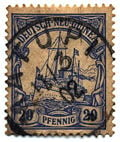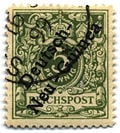German New Guinea
{Infobox Former Country |native_name = Deutsch-Neuguinea |conventional_long_name = German New Guinea |common_name = New Guinea |continent = Oceania |region = Melanesia |status=Colony |empire=Germany |status_text=Colony of Germany |year_start = 1884 |year_end = 1919 |date_start = November 3 |date_end = June 28 |event_start = Colonization |event_end= Treaty of Versailles |s1 = South Pacific Mandate |s2 = North Solomon Islands |s3 = New Zealand |s4 = Territory of New Guinea |flag_s1 = Flag of Japan - variant.svg |flag_s2 = Flag of the United Kingdom.svg |flag_s3 = Flag of New Zealand.svg |flag_s4 = Flag of Australia.svg |image_flag = German new guinea flag.svg |image_coat = Neuguinea.PNG |image_map = German Pacific.png |image_map_caption = Brown = German New Guinea; Pink= German Pacific Protectorates; Red= German Samoa |capital = Herbertshöhe (Kokopo) Rabaul (after 1910) |common_languages = German (official), Austronesian languages, Papuan languages, German creoles |title_leader = King |leader1 = List of German monarchs |title_representative = Governor |representative1 = List of colonial heads of New Guinea |title_deputy = |deputy1 = |era = German colonization |currency = Goldmark }}
German New Guinea (Ger. Deutsch-Neuguinea) was a former German protectorate from 1884 to 1914, consisting of the northeastern part of New Guinea and several nearby island groups. German New Guinea is now entirely part of Papua New Guinea.
The main part of German New Guinea was formed by Kaiser-Wilhelmsland, the northeastern part of New Guinea. The islands to the east of Kaiser-Wilhelmsland were called the Bismarck Archipelago and consisted of Neu-Pommern (or New Pomerania, now New Britain) and Neu-Mecklenburg (now New Ireland).
With the exception of German Samoa, all German islands in the Pacific were administratively part of German New Guinea: the German Solomon Islands (Buka, Bougainville and several smaller islands), the Carolines, Palau, the Marianas (except for Guam), the Marshall Islands and Nauru. Total land area was 249,500 km². [1]
History
Although the western half of New Guinea had been administered by the Netherlands for some time, the eastern half had not yet been annexed by any European power until the 1880s. In 1883, the British colony of Queensland (Australia) annexed the southeastern part of New Guinea against the wishes of the British government. This initiated German interest in the remaining third of the island. On 3 November 1884, under the flag of the newly founded Neuguinea-Kompanie (New Guinea Company), the German flag was flown over Kaiser-Wilhelmsland, the Bismarck Archipelago (formerly New Britain) and the German Solomon Islands.
On 1 April 1899 the German government formally took control of these lands, and the area became a protectorate. A treaty with Spain, signed later that year on 30 July, ensured German control over several island groups in the Pacific, and these were added to the protectorate of German New Guinea. The Marshall Islands were added in 1906.
Following the outbreak of World War I, Australian troops captured Kaiser-Wilhelmsland and the nearby islands in 1914, after a short resistance led by Captain Carl von Klewitz and Lt. Robert "Lord Bob" von Blumenthal, while Japan occupied most of the remaining German possessions in the Pacific. The only significant battle occurred on 11 September 1914 when the Australian Naval and Military Expeditionary Force attacked the low-power wireless station at Bitapaka (near Rabaul) on the island of New Britain (Neu Pommern). The Australians suffered six dead and four wounded—the first Australian military casualties of the First World War. The German forces fared much worse, with one German officer and 30 native police killed and 1 German officer and ten native police wounded. On 21 September all German forces in the colony surrendered.
However, Leutnant (later Hauptmann) Hermann Detzner, a German officer, and some 20 native police evaded capture in the interior of New Guinea for the entire war. Unbeknownst to Detzner, the war had started while he was still on a surveying expedition to map the border with Australian-held Papua. He claimed to have penetrated the interior of the German portion (Kaiser Wilhelmsland) in his 1920 book Vier Jahre unter Kannibalen ("Four Years Among Cannibals"). These claims were heavily disputed by various German missionaries, and Detzner recanted most of his claims in 1932.
After the Treaty of Versailles of 1919, Germany lost all its colonial possessions, including German New Guinea. It became the Territory of New Guinea, a League of Nations Mandate Territory under Australian administration until 1949 when it was merged with the Australian territory of Papua to become the Territory of Papua and New Guinea, which eventually became modern Papua New Guinea.
Postage stamps
The first postage stamps of the colony were issued in 1897, as overprints reading "Deutsch - / Neu-Guinea" on the current stamps of Germany. In 1901, the Yacht issue included stamps for the colony, inscribed "DEUTSCH-NEU-GUINEA." The 5pf, 10pf, and 5m values were reprinted in 1914 on watermarked paper and inscribed "DEUTSCH-NEUGUINEA," but these did not reach the colony before it was occupied and were never put in use, nor was the reprint of the 3pf value made in 1919.
The stamps are available to collectors today at prices ranging from about $1 US, up to $500 for a validly used 5m stamp. Very few stamps of the higher values were ever used, and their prices are 10-20 times higher than for mint copies. Fake cancellations exist.
After the Australian occupation, stocks of the unwatermarked stamps, along with some registration labels, were overprinted with "G.R.I." and a value in pence or shillings; see New Britain for further details.
See also
- New Guinea
- Papua (Indonesian province)
- Irian Jaya
- Western New Guinea
- British New Guinea
- Dutch New Guinea
- Unserdeutsch language
- Kaiser-Wilhelmsland
- HMAS AE1 First Australian submarine
External links
Template:Former German colonies
Credits
New World Encyclopedia writers and editors rewrote and completed the Wikipedia article in accordance with New World Encyclopedia standards. This article abides by terms of the Creative Commons CC-by-sa 3.0 License (CC-by-sa), which may be used and disseminated with proper attribution. Credit is due under the terms of this license that can reference both the New World Encyclopedia contributors and the selfless volunteer contributors of the Wikimedia Foundation. To cite this article click here for a list of acceptable citing formats.The history of earlier contributions by wikipedians is accessible to researchers here:
The history of this article since it was imported to New World Encyclopedia:
Note: Some restrictions may apply to use of individual images which are separately licensed.

